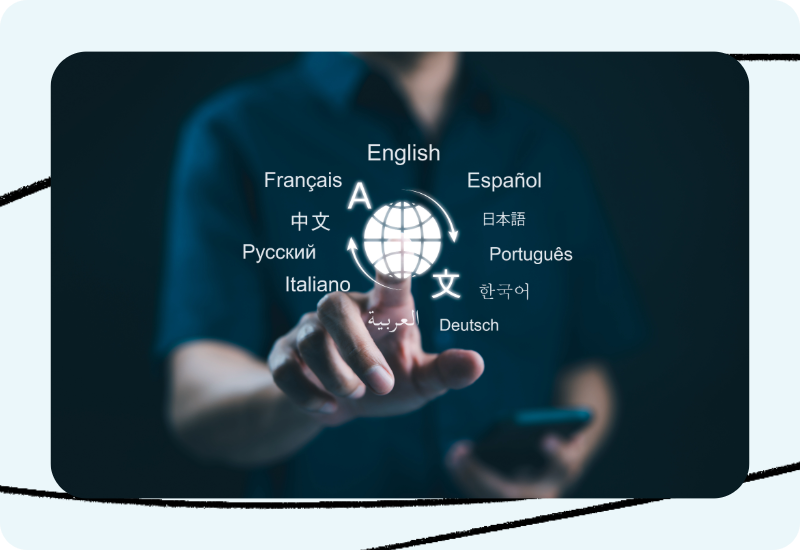In high-stakes, high-impact environments like international conferences, courtroom proceedings, healthcare settings, humanitarian missions, and customer service hotlines, interpretation is essential to cross-cultural communication. Whether you’re a professional in these fields or someone responsible for clear multilingual interactions, understanding the different modes of interpretation matters. Clarifying these distinctions helps businesses make sure the right approach is applied in the right context, especially as technology begins to influence and change how interpretation is delivered and the resulting output. At the end of the day, interpretation remains a human-centered service, but AI now plays a crucial role in making it faster, smarter, and increasingly equitable.
In recent years, AI-powered tools for interpretation have made significant progress, especially in controlled environments like virtual meetings and live-streamed events. Platforms like Zoom and Interprefy now offer real-time captioning and multilingual audio channels where interpretation can be supported by both human and AI interpreters.
Meanwhile, large tech companies are investing in speech recognition and neural machine interpreting models, aiming to reduce latency and improve contextual accuracy. While fully autonomous AI interpretation isn’t yet reliable for nuanced or high-stakes scenarios, hybrid models—where AI supports human interpreters—are becoming more viable and widely adopted.
Below, we explore the classic modes of interpretation, updated to reflect today’s AI opportunities and drawbacks, including cultural awareness, accuracy, and responsibility.
1. Consecutive Interpretation
In consecutive interpretation, the speaker delivers a few sentences or minutes of speech, then pauses to allow the interpreter to relay the message in the target language. Most often used in legal settings, interviews, and negotiations where accuracy and clarity are critical, this approach allows for thoughtful delivery
Today, consecutive interpreters may rely on AI-assisted tools for notetaking, terminology management, or real-time references. These innovations support memory retention, especially for longer stretches of speech.
2. Simultaneous Interpretation
Simultaneous interpretation involves real-time translation with only a few seconds’ delay. Commonly used in large conferences, diplomatic summits, and multilingual broadcasts, this mode demands extraordinary focus and fluency. The interpreter listens, processes, and speaks—all at once—without interrupting the speaker.
AI tools are increasingly involved in these environments, offering features like automated audio routing, speech-to-text feeds, or predictive glossary suggestions. However, while the technology aids efficiency, it still falls short in high-context or emotionally charged discussions.
Simultaneous interpretation remains one of the most cognitively demanding jobs, and even the best AI tools still can’t replace the instinctive judgment of a trained interpreter managing multiple languages and shifting cultural references on the fly.
3. Whisper (Chuchotage) Interpretation
Whisper interpretation is a low-tech, high-skill format of simultaneous interpretation used during small meetings, legal settings, site visits, or private conversations. The interpreter literally whispers the translation in real time to one or two individuals, seated closely beside them, without the need for headsets or microphones.
However, in slightly larger settings—such as small-group tours or high-level meetings—interpreters may use portable whisper systems with low-range transmitters and earpieces. This light tech solution helps reduce vocal strain and ensures clarity while still preserving the intimate nature of the communication.
While AI tools may support preparation, like preloading event vocabulary or reviewing scripts, real-time chuchotage interpreting depends entirely on the skill of the professional interpreter. Tone, intent, body language, and context are all interpreted on the fly. In diplomatic or confidential meetings, this approach ensures discretion, immediacy, and human nuance—none of which AI can replicate in such a personal format.
4. Video Remote Interpretation (VRI)
VRI services are designed to meet the growing demand for fast, flexible, and high-quality language access, without sacrificing the power of visual context. VRI can connect clients with qualified interpreters in seconds, offering critical support in settings where facial expressions, gestures, and nonverbal cues are essential to understanding.
In VRI AI can support scheduling, call routing, and real-time reporting behind the scenes, while the VRI session is led by a trained human interpreter. A hybrid model like this can offer speed and scale without compromising the cultural sensitivity and contextual accuracy that define quality Interpretation.
5. Over‑the‑Phone Interpretation (OPI)
OPI offers on-demand access to interpreters across hundreds of languages. It’s widely used in customer service, healthcare, government services, and emergency response situations. OPI can be simultaneous or consecutive, depending on the context, and is highly valued for its scalability and availability.
AI assists in routing, caller authentication, and service matching, speeding up access and improving efficiency.
AI for Over-the-Phone Interpretation (OPI) has seen rapid development, thanks to advances in real-time speech recognition and voice synthesis. Some language service providers now offer AI-assisted options for routine, low-stakes interactions, such as customer service inquiries or simple transactional calls. These tools can manage predictable dialogues in high-resource languages with growing fluency, offering speed and cost-efficiency in specific use cases.
However, major limitations remain. Most AI OPI solutions support only a limited range of languages, and often falter when faced with regional accents, code-switching, or non-standard speech. More critically, they lack the cultural sensitivity, emotional intelligence, and adaptive reasoning that human interpreters apply instinctively. While AI can play a supportive role in streamlining workflows, it is not yet a dependable replacement in high-stakes, sensitive, or nuanced conversations.
AI Used Pragmatically in Interpretation: Quality Assurance and Performance Optimization
Real-time interpretation is inherently high-pressure and high stakes. Unlike translation, there’s no time to pause, revise, or backtrack. That’s why AI plays a distinct and supportive role here: not in replacing interpreters, but in enhancing how we train, evaluate, and support them.
In a recent blog post on AI, Automation, and the Future of Language Services, Dan Nelson our Chief Operating Officer states “AI is not about replacing humans—it’s about increasing throughput and consistency in a world that demands both.”
Dan goes on to explain that one of the most promising applications is AI-driven call analysis. Instead of manually sampling a small number of interpreted calls each month, AI allows us to review a much broader dataset. This gives us a more accurate view of performance indicators like response times, service quality, and accuracy across interactions.
AI also enhances training and feedback loops. By generating transcripts and identifying trends, trainers can pinpoint where interpreters excel—or struggle—and deliver more focused, data-backed coaching. This enables more consistent performance improvement than relying solely on spot checks or anecdotal reviews.
Looking ahead, automated quality assurance (QA) powered by AI is on our 12-month roadmap, marking a shift from reactive evaluations to real-time, scalable insights.
The AI + Human Hybrid Approach—Best of Both Worlds
AI cannot read body language, interpret emotional tone, or understand cultural nuance, so human interpreters are indispensable in maintaining contextual accuracy and cultural sensitivity, especially in high-stakes settings like courtrooms or medical consultations.
Translation is never just about literal meaning; it’s about people, identity, and lived experience.
When AI interpretation systems mishandle idioms, overlook community-specific language, or ignore the discomfort of the person in the room they create messages that sound “correct” but fail to transfer the correct meaning. These are not just technical misfires—they’re barriers to equity, access, and opportunity.
And the stakes are high: in healthcare interpretation, inaccurate translation can lead to misdiagnosis. In legal settings, it can impact a verdict. In public services, it can cost lives.
That’s why we’ve embraced a hybrid model—combining human interpreters with AI-driven tools to deliver quality, precision and scalability. At BIG the goal is not to replace people but to strengthen outcomes by blending human insight with machine efficiency.
Are you ready to improve the efficiency and effectiveness of your interpretation program?
Contact BIG Language Solutions— we can help you select the right mode of interpretation and build the right approach to delivering the services your customers, members, and patients need.





